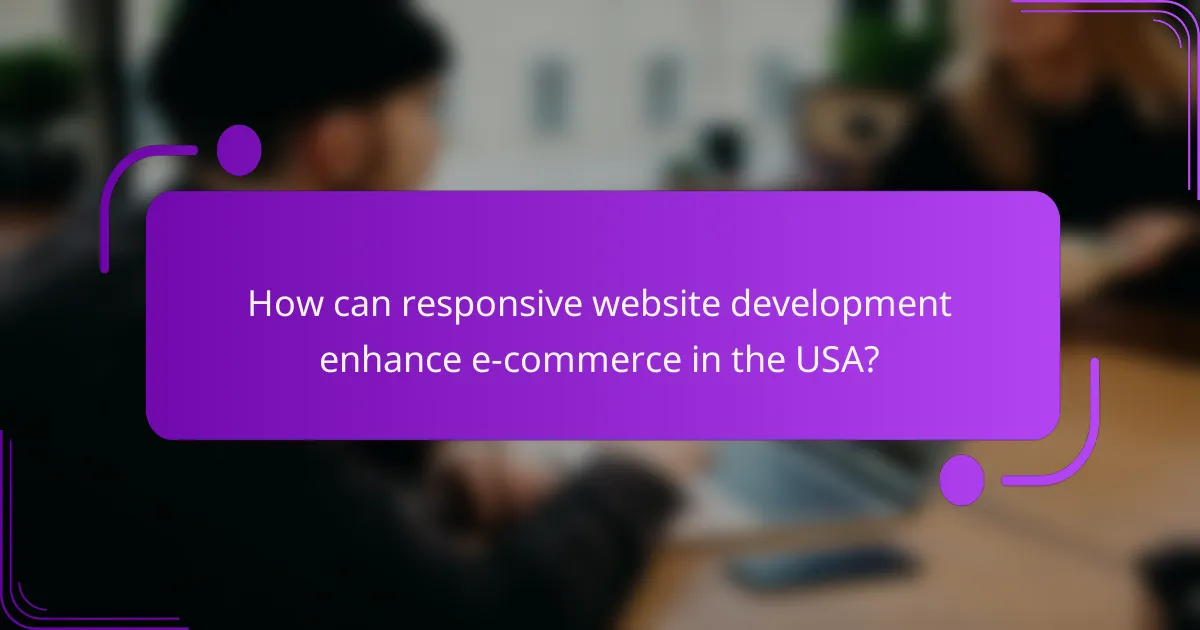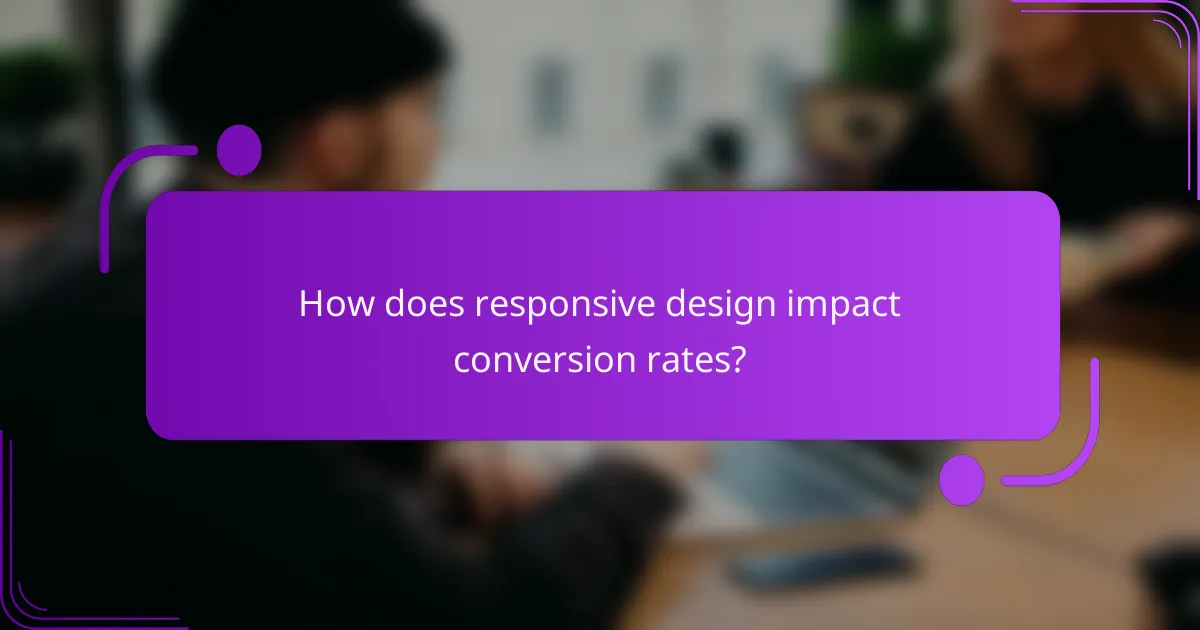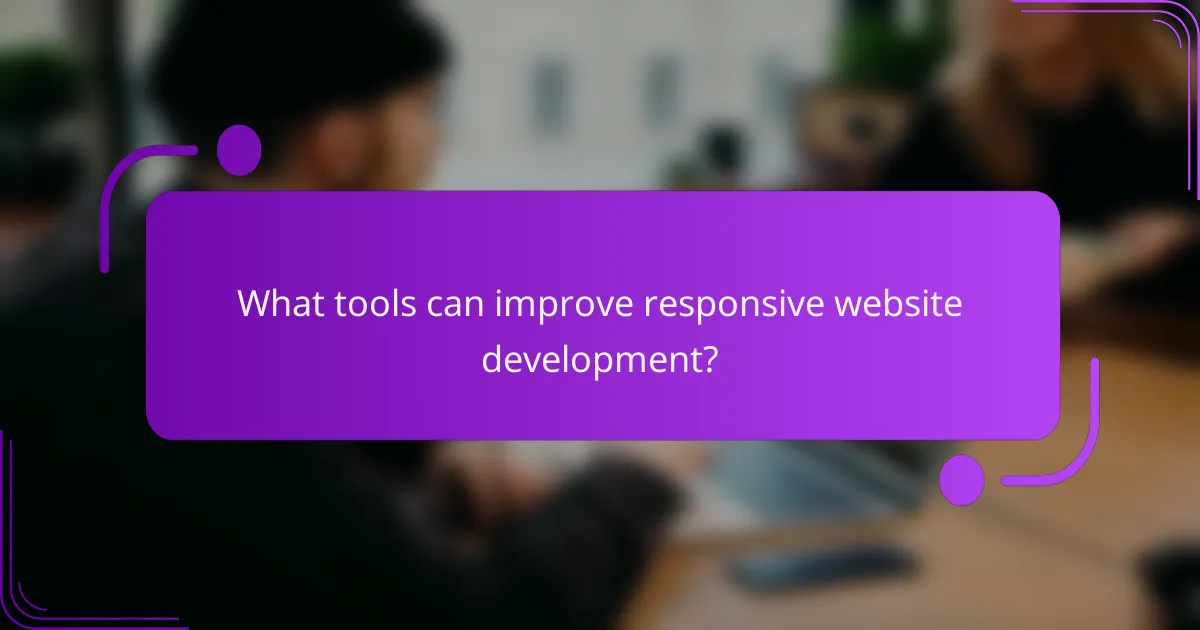Responsive website development is crucial for e-commerce success, as it ensures online stores are accessible and user-friendly on all devices. By creating a seamless and intuitive interface, businesses can enhance user experience, ultimately boosting conversion rates and customer satisfaction.

How can responsive website development enhance e-commerce in the USA?
Responsive website development significantly improves e-commerce by ensuring that online stores are accessible and user-friendly across various devices. This adaptability leads to better user experiences, which can ultimately boost conversion rates and customer satisfaction.
Improved mobile accessibility
With a growing number of consumers shopping via smartphones, responsive design is essential for e-commerce success. A responsive website automatically adjusts its layout and content to fit any screen size, making it easier for mobile users to navigate and make purchases.
To enhance mobile accessibility, prioritize touch-friendly elements such as larger buttons and simplified navigation menus. Avoid complex layouts that may frustrate users on smaller screens.
Faster loading times
Responsive websites typically load faster on mobile devices, which is crucial for retaining visitors. Studies indicate that even a one-second delay can lead to significant drops in conversion rates, particularly in e-commerce.
To improve loading times, optimize images and minimize the use of heavy scripts. Tools like Google PageSpeed Insights can help identify areas for improvement, ensuring that your site loads quickly across all devices.
Better user engagement
Engaging users effectively is key to driving sales in e-commerce. A responsive design enhances user engagement by providing a seamless experience, encouraging visitors to explore products and complete purchases.
Incorporate interactive elements such as product sliders and customer reviews to keep users interested. Additionally, ensure that content is easily readable without excessive zooming or scrolling.
Higher search engine rankings
Search engines like Google prioritize mobile-friendly websites in their rankings, making responsive design a vital component of SEO strategy. A higher ranking increases visibility, driving more traffic to your e-commerce site.
To boost your search engine rankings, ensure that your responsive site adheres to best practices, such as using proper meta tags and maintaining a fast loading speed. Regularly update content to keep it relevant and engaging for both users and search engines.

What are the best practices for optimizing user experience on e-commerce sites?
To optimize user experience on e-commerce sites, focus on creating a seamless, intuitive interface that enhances customer satisfaction and encourages purchases. Key practices include streamlined navigation, consistent branding, and personalized content tailored to user preferences.
Streamlined navigation
Streamlined navigation is crucial for helping users find products quickly and easily. Implement a clear menu structure with categories and subcategories that reflect your product offerings. Consider using a search bar that auto-suggests products to further enhance the browsing experience.
Ensure that navigation elements are accessible on all devices, particularly mobile, where a significant portion of e-commerce traffic originates. Avoid cluttering the navigation with too many options, as this can overwhelm users and lead to frustration.
Consistent branding
Consistent branding across your e-commerce site fosters trust and recognition among customers. Use a cohesive color palette, typography, and imagery that aligns with your brand identity. This consistency should extend to all pages, including product listings, checkout, and customer service sections.
Incorporate your logo and brand messaging prominently to reinforce your identity. This not only enhances user experience but also encourages repeat visits, as customers become familiar with your brand’s look and feel.
Personalized content
Personalized content significantly enhances user experience by catering to individual preferences and behaviors. Utilize data analytics to track user interactions and recommend products based on past purchases or browsing history. This can lead to higher engagement and conversion rates.
Consider implementing features like personalized email marketing campaigns or tailored landing pages that reflect users’ interests. However, ensure that personalization respects user privacy and complies with regulations, such as GDPR, to maintain trust.

How does responsive design impact conversion rates?
Responsive design significantly enhances conversion rates by ensuring that e-commerce websites function seamlessly across various devices. When users can easily navigate and interact with a site on their smartphones or tablets, they are more likely to complete purchases, leading to increased sales.
Increased sales through mobile users
With a growing number of consumers shopping via mobile devices, responsive design is crucial for capturing this audience. Research indicates that mobile users account for a substantial portion of online sales, often exceeding 50% in certain markets. Ensuring that your site is optimized for mobile can lead to a noticeable boost in revenue.
To maximize sales from mobile users, focus on simplifying the checkout process and minimizing loading times. A streamlined experience can reduce cart abandonment rates, which are often higher on mobile if the site is not responsive.
Reduced bounce rates
Responsive design helps reduce bounce rates by providing a consistent and user-friendly experience across devices. When visitors find a site that is easy to navigate and visually appealing on their device, they are more likely to stay longer and explore more pages.
To further decrease bounce rates, ensure that your website loads quickly and that key information is easily accessible. Aim for load times under three seconds, as delays can lead to significant user drop-off.
Enhanced customer trust
A well-designed, responsive website fosters trust among users, as it reflects professionalism and attention to detail. Customers are more likely to engage with a brand that offers a seamless experience across all devices, which can translate into higher conversion rates.
To build trust, incorporate elements such as secure payment options, clear contact information, and customer reviews. These factors, combined with a responsive design, can significantly enhance the overall user experience and encourage repeat business.

What tools can improve responsive website development?
Several tools can significantly enhance responsive website development by optimizing design, usability, and performance. Utilizing these tools can lead to better user experiences and higher conversion rates for e-commerce sites.
Google Mobile-Friendly Test
The Google Mobile-Friendly Test is a straightforward tool that evaluates how well a website performs on mobile devices. It analyzes the page’s content and layout, providing insights on usability issues that may hinder mobile users.
To use the tool, simply enter your website’s URL, and it will generate a report indicating whether the site is mobile-friendly. Common issues include text too small to read and links that are too close together, which can negatively impact user experience.
Adobe XD for design
Adobe XD is a powerful design tool that allows developers and designers to create responsive layouts and prototypes. It supports collaboration, enabling teams to work together seamlessly on design projects.
With features like artboards and responsive resizing, Adobe XD helps ensure that designs adapt well across various screen sizes. Consider using plugins for additional functionality, such as accessibility checks or design systems integration.
Bootstrap for frameworks
Bootstrap is a popular front-end framework that simplifies the process of developing responsive websites. It provides a grid system and pre-designed components that help maintain consistency and speed up development.
When using Bootstrap, developers can leverage its responsive utilities to hide or show elements based on screen size. This flexibility allows for a tailored experience across devices. Be mindful of potential over-reliance on the framework, which can lead to uniformity in design if not customized effectively.

What criteria should businesses consider when selecting a responsive web development agency?
Businesses should evaluate several key criteria when choosing a responsive web development agency, including their portfolio, client feedback, and specific expertise in e-commerce. These factors can significantly influence the effectiveness of the website in enhancing user experience and boosting conversion rates.
Portfolio of past projects
A strong portfolio showcases the agency’s previous work and demonstrates their ability to create visually appealing and functional websites. Look for examples that highlight responsive design across various devices and industries, particularly in e-commerce.
Consider the diversity of projects in their portfolio. An agency that has worked with different business sizes and sectors may bring valuable insights and innovative solutions tailored to your needs.
Client testimonials
Client testimonials provide insight into the agency’s reliability, communication, and overall satisfaction. Seek out reviews that specifically mention the agency’s responsiveness and ability to meet deadlines, as these are crucial for successful project completion.
Additionally, look for case studies that detail the agency’s impact on previous clients’ e-commerce performance, such as increased traffic or improved conversion rates, which can indicate their effectiveness in the field.
Expertise in e-commerce
Choosing an agency with proven expertise in e-commerce is essential for optimizing your online store. They should understand the unique challenges of e-commerce websites, such as payment processing, inventory management, and user navigation.
Inquire about their familiarity with e-commerce platforms like Shopify, WooCommerce, or Magento, and their ability to implement best practices for SEO and user experience. This knowledge can directly contribute to higher conversion rates and customer satisfaction.

What are the emerging trends in responsive website development for e-commerce?
Emerging trends in responsive website development for e-commerce focus on enhancing user experience and increasing conversion rates. Key trends include AI-driven personalization and voice search optimization, which cater to evolving consumer behaviors and preferences.
AI-driven personalization
AI-driven personalization tailors the shopping experience to individual users by analyzing their behavior and preferences. This technology can recommend products based on past purchases, browsing history, and demographic data, making the shopping experience more relevant and engaging.
To implement AI-driven personalization effectively, e-commerce sites should utilize data analytics tools that track user interactions. Consider integrating recommendation engines that suggest items based on user profiles, which can increase average order values by up to 30% in some cases.
However, be cautious about privacy concerns. Ensure compliance with regulations like GDPR in Europe, which mandates transparency in data usage and user consent.
Voice search optimization
Voice search optimization enhances user experience by allowing customers to search for products using voice commands. This trend is growing as more consumers use smart speakers and mobile devices for shopping, making it essential for e-commerce sites to adapt.
To optimize for voice search, focus on natural language processing and long-tail keywords that reflect how people speak. For example, instead of targeting “running shoes,” consider phrases like “best running shoes for flat feet.” This approach can improve visibility in voice search results.
Additionally, ensure that your website loads quickly and is mobile-friendly, as voice searches often occur on mobile devices. Aim for loading times under three seconds to reduce bounce rates and enhance user satisfaction.
